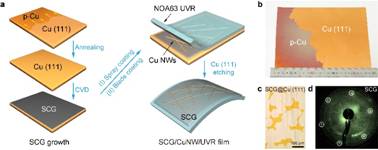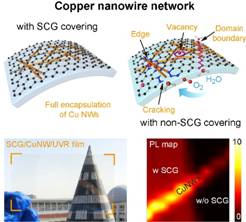Recently, Professor Chen Ke's research team of our center has made new progress in the field of graphene research,and the related results have been published in the famous international journal Nano Energy (2020,71, 104638;IF=16.602) under the title “Superstable copper nanowire network electrodes by single-crystal graphene covering and their applications in flexible nanogenerator and light-emitting diode”. Paper link:https://doi.org/10.1016/j.nanoen.2020.104638.
The development of flexible transparent electrodes with low cost and high stability is of great practical significance to the development of intelligent wearable devices, human-computer interaction systems and other emerging technologies. Copper nanowires have almost the same electrical conductivity as silver, but have higher cost-effectiveness, and have a broad application prospect in the fields of flexible electronic products, large-size touch screen displays and triboelectric energy collectors. However, the problem that copper is easily oxidized leads to a significant decrease in its electrical conductivity, which seriously affects the practical application of copper nanowires in the field of transparent electrodes. How to prevent the oxidation of copper nanowire grid without sacrificing its transmittance has become a key problem to be solved urgently.

Fig. 1 Design and preparation of flexible transparent electrode for monocrystalline graphene/copper nanowires
The highlight of this work is the development of a layer-to-layer stack assembly method of single crystalline graphene protective copper nanowire flexible transparent electrodes (Figure 1).First of all, about 10 inches of monocrystalline graphene film was grown on the surface of the Cu(111) monocrystalline substrate annealed by industrial copper foil by chemical vapor deposition, and then a sandwich structure monocrystalline graphene/copper nanowire mesh/photocurable resin (SCG/CuNW/UVR) composite film was prepared and confirmed. It has photoelectric performance and high mechanical strength comparable to commercial ITO. Single crystal graphene has excellent conductivity and high impermeability ,which can effectively prevent the infiltration of water and oxygen molecules from the external environment to the graphene / copper interface (Figure 2), thus avoiding the accelerated corrosion of copper caused by primary battery reaction. The anti-oxidation stability and acid corrosion resistance of copper electrode are significantly enhanced. At the same time, the layer-by-layer assembly process not only overcomes the common problems of film wrinkling and fouling in graphene transfer process, but also reduces the surface roughness of copper nanowire network and obtains ultra-smooth electrode surface.On the basis of work, flexible friction nano-generators and quantum dot light-emitting diodes are successfully constructed based on SCG/CuNW/UVR transparent electrodes. The above research provides a new idea for the industrial application of large area single crystal graphene thin films and the large-scale manufacture of high performance flexible electronic devices.

Fig. 2 Metal anti-corrosion mechanism of single crystal graphene/copper nanowire flexible transparent electrode
Wang Jianwei ,master of Henan University, Wang Shujie , associate professor of Henan University and Zhang Zhihong, postdoctoral fellow of Peking University are the co-first authors of the paper. Professor Chen Ke and researcher Liu Kaihui of Peking University are the co corresponding authors. The School of Physics and Electronics of Henan University is the first signing unit, and the cooperative units include the School of Physics of Peking University and the Laboratory of Special Functional Materials of Henan University. This work has been supported by the National Natural Science Foundation of China, the key project of basic research of the Department of education, the Central Plains thousand talents plan of Henan Province, the Youth Talents Plan of Henan University and other projects.